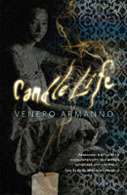 | Venero Armanno CANDLE LIFE Vintage, 349 pp. Review by Perry Middlemiss |
An unnamed Australian novelist is living in Paris, mourning the death of his lover, and struggling to recapture the rhythm of writing. He spends his waking hours thinking of her, reliving his life with her, and wandering the streets of the city. It's out on the streets that he comes into contact with a Black Cuban-American beggar named Jackson "Sonny" Lee, who gradually insinuates himself into the writer's life, and who eventually leads him to the catacombs under Paris, where the novel's ending is played out. In the meantime, the novelist has a friend die in his artist commune apartment, takes that friend's niece as a lover, gets involved with a mute Russian prostitute and generally has a hard time getting on with his life.
There seems to be a lot of symbols populating this book, and, as indicated by the novel's title Armanno uses the presence of candles throughout the book as a motif indicating life and stability.
My rugged accumulation of mountainous wax is as tall as a table and as wide as a television. When the power goes out, which it does to the point of clockwork madness, all I have to do is find the black stub of a wick in all that gloop and light it with a match. The thing is made of the remnants of hundreds of candles, and there are black wicks by the score. I can choose to light one or a dozen.And later, Sonny tells him:
I took note of that giant candle thing in your room at the commune. I guess that was supposed to be the candle of enlighment. One flame lights the next and the next and the next etcetera. But any good guru will tell you that underneath a candle is always the darkest place of all, so how does that sit with whatever that mountain of congealed wax was supposed to mean?His life's ebbs and flows become defined by his candles and when he is evicted from the commune the giant wax sculpture is destroyed by the cleaners. From that time on his life starts running out of control. He moves in with Lee and oscillates back and forth between his French and Russian lovers, fixated with both in turn, unable to decide where his best options lie.
It is hard not to think that we are being shown a journey here: a journey from the light into the darkness and back out again. Armanno's protagonist follows a path that seems to mirror parts of Joseph Campbell's hero myth-cycle: the journey to Paris as "the call to adventure", the meeting with Sonny as "supernatural aid", his lovers as "the meeting with the goddess" and his journey into Paris's catacombs as the "road of trials" and the trip to the underworld. The narrator has entered a world he does not fully understand and from which he always feels alienated. That, along with the use of symbols and motifs, supports this mythological reading.
The problem is that Campbell's outline is at its dullest when the return from the "otherworld" is denied, when the hero decides to remain behind and not to reveal his new-found knowledge, and it is this path that Armanno appears to have taken with this novel. I say "appears" because the ending of this book is obscure and confused; a drug-enduced blundering though the passageways of the catacombs and the byways of history. I can only assume that the author meant it to be that way. But I've always had trouble with dream and drug sequences - I never think they work effectively.
Armanno has written a complex and, for the most part, compelling novel. There is a lot to admire about his descriptions of the streets of Paris, the interactions between the characters, and the strange and mysterious history of Lee. It's just a pity he couldn't find a satisfactory way to end it.
